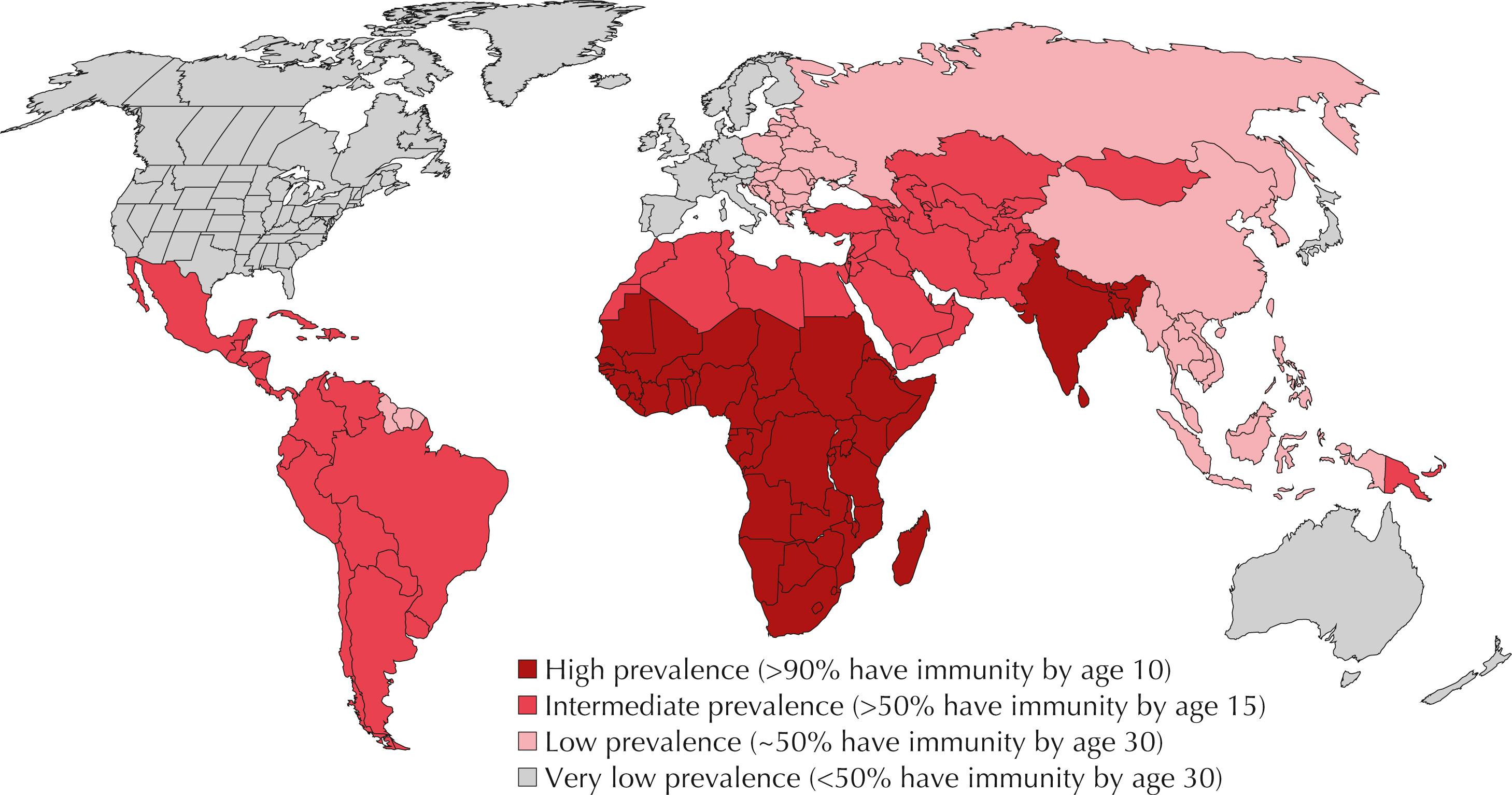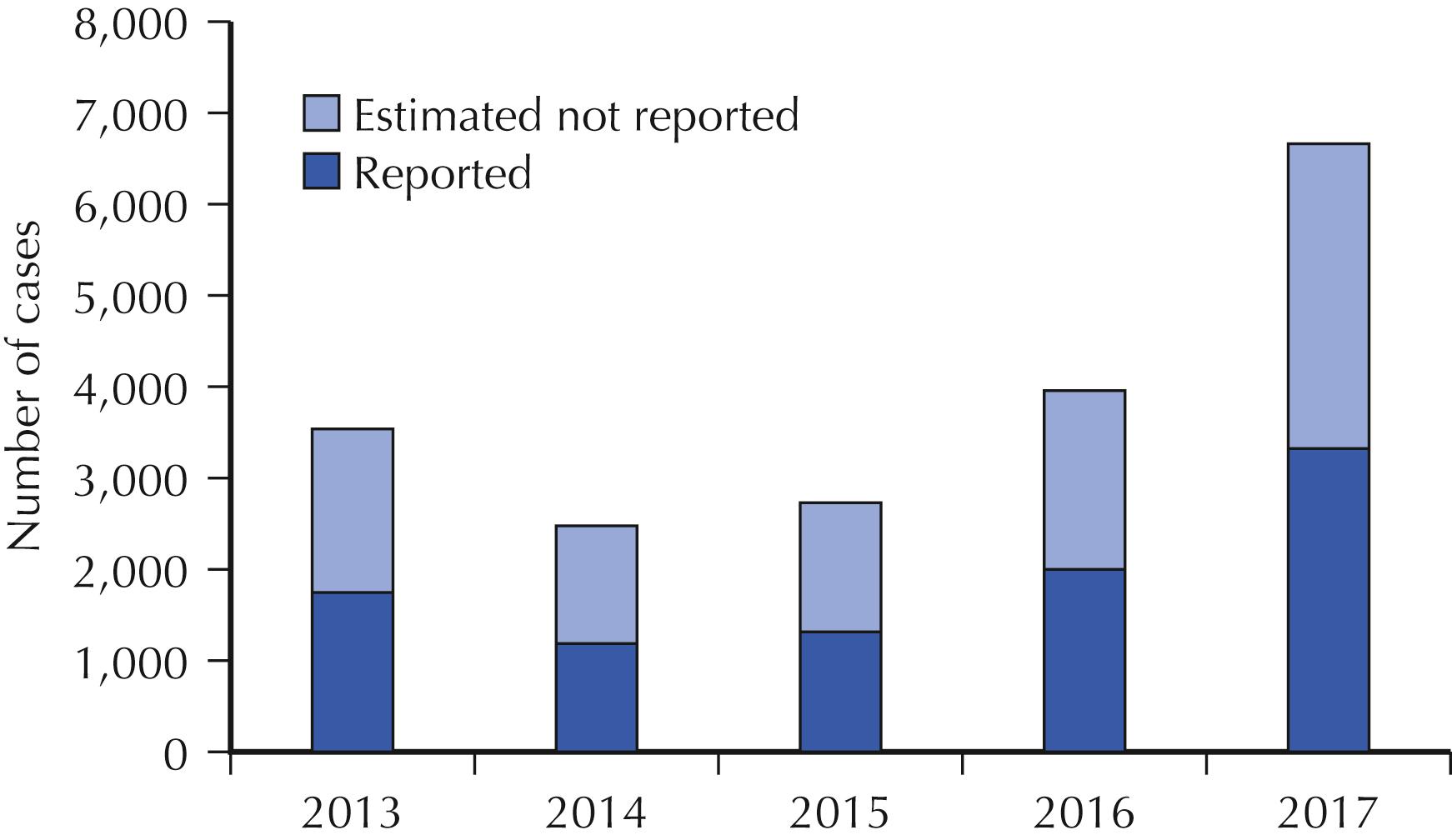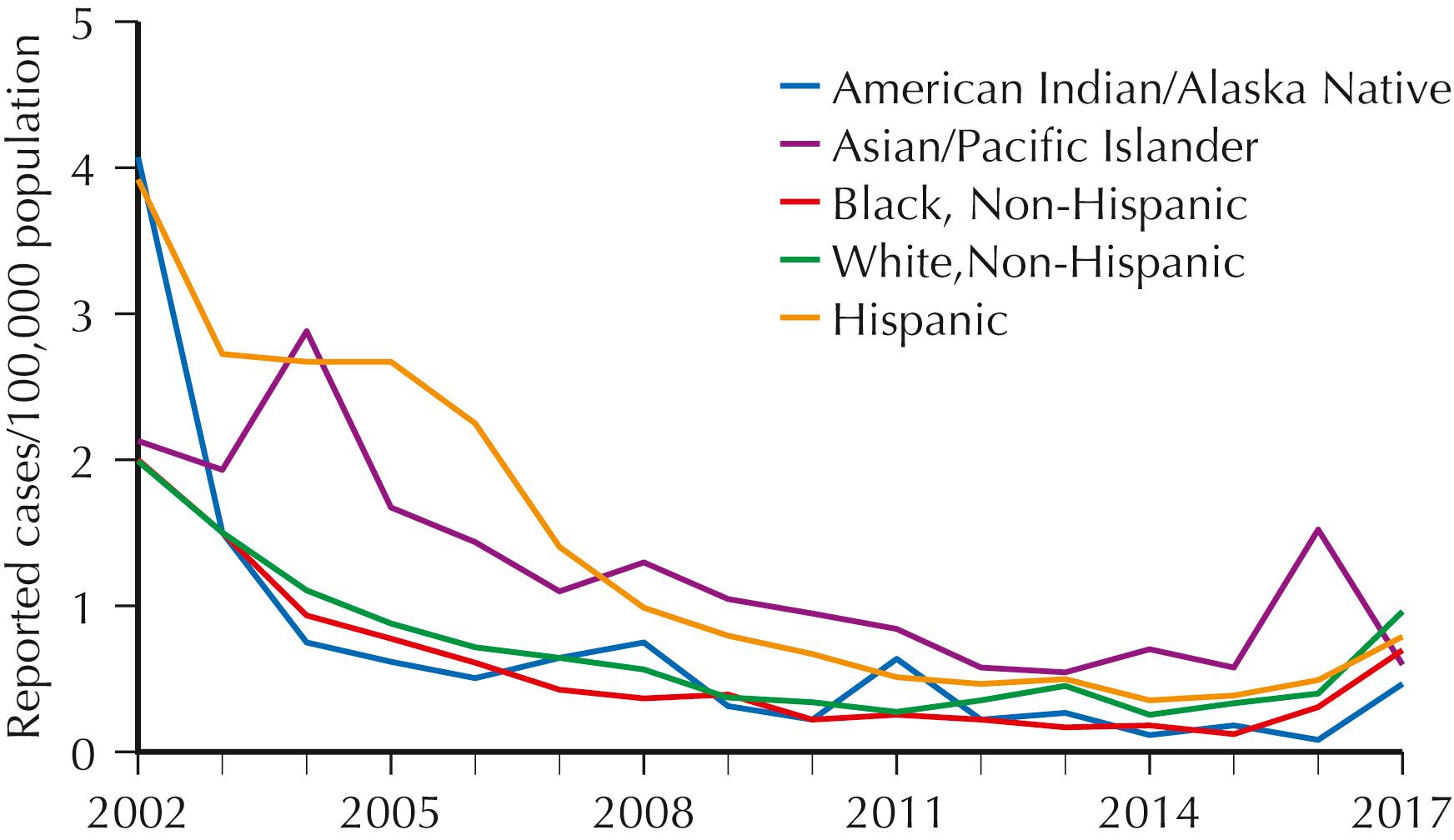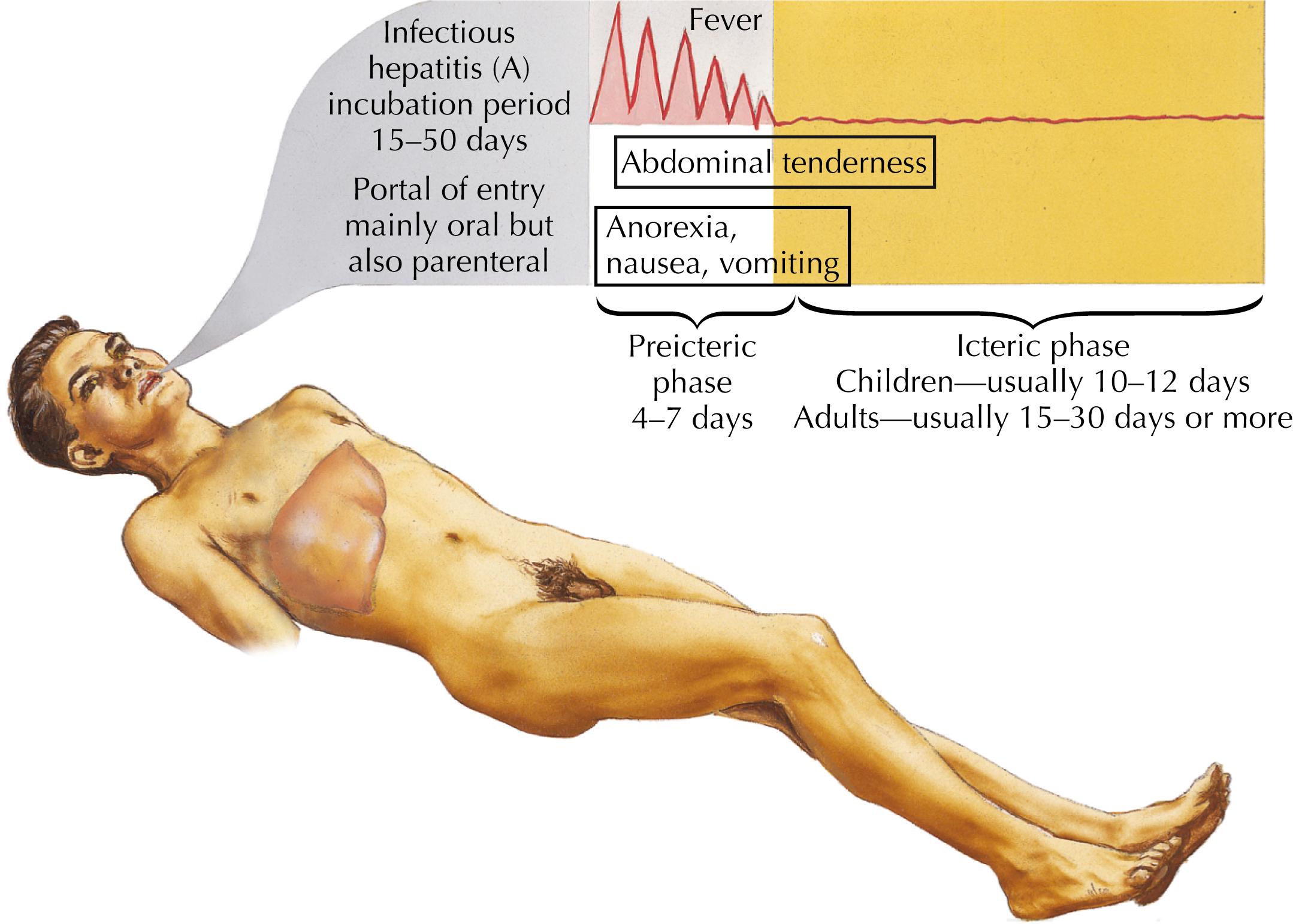Physical Address
304 North Cardinal St.
Dorchester Center, MA 02124
Hepatitis A infection is the most common cause of viral hepatitis worldwide and a commonly reported vaccine-preventable disease in the United States. Clinical illness—characterized by fever, malaise, jaundice, and nausea—caused by hepatitis A virus (HAV) is similar to hepatitis caused by other viral pathogens. Although most cases of hepatitis A are self-limited, fulminant hepatitis resulting in death may occur. Widespread routine childhood vaccination against hepatitis A has resulted in a significant decline in hepatitis A infections, with a notable diminishment of previous racial or ethnic and geographic disparities.
A 14-year-old female presents to her local emergency room with a history of fatigue and intermittent abdominal pain with poor appetite for 1 week. This morning her mother noticed that the whites of her eyes looked yellow. In the emergency room she has a temperature of 101.5°F, heart rate 130/min, blood pressure 110/68 mm Hg, and respiratory rate 16/min. On exam, she is tired appearing with dry mucosal membranes and faint scleral icterus. Her abdomen is distended and tender to palpation; her liver is 3 cm below the costal margin. The girl’s mother reports that she doesn’t believe in vaccines and wants her children to “build their own immunity.” The patient denies sick contacts. She and the rest of the family have been busy welcoming the arrival of her new 3-year-old adopted sister, who arrived from China 1 month earlier.
COMMENT: The patient presented with signs and symptoms compatible with a diagnosis of acute hepatitis. Given the recent addition to the family of a 3-year-old child adopted from China, the most likely diagnosis is acute hepatitis A. However, given the history of the mother’s vaccine hesitancy, the patient could lack other standard childhood immunizations and be susceptible to hepatitis B, as there is also a risk of transmission of hepatitis B to close contacts of an adopted orphan coming from a highly endemic country. Both hepatitis A and B serologic tests were sent to the laboratory; the IgM anti–hepatitis A virus antibody test was reported back positive.
Hepatitis A infection is caused by HAV, a ribonucleic acid (RNA) virus in the genus Hepatovirus within the family Picornaviridae. HAV is an icosahedral nonenveloped virus that replicates in the cytoplasm. The genome consists of single-stranded RNA that encodes information for 11 individual proteins. There are four closely related genotypes of human HAV strains but only one major serotype.
Approximately 1.5 million cases of hepatitis A are reported each year worldwide, and the prevalence of antibodies (indicating previous infection) in the population can vary from 15% to nearly 100% in some countries. Hepatitis A infection remains highly endemic in Africa, India, Central and South America, the Middle East, and Asia. In developing areas of the world, most adults show serologic evidence of past infection. Nordic countries show the lowest prevalence of infection, approximately 15%. In other parts of Europe, Australia, Japan, and the United States, the seroprevalence of antibodies to HAV is 30% to 70% in adults ( Fig. 14.1 ).

In the United States, the incidence of hepatitis A has significantly declined since the late 1990s, when hepatitis A vaccines came into wider use. In the prevaccine era, the incidence of hepatitis A in the United States was cyclic, with nationwide increases occurring every 10 to 15 years, often linked to foodborne outbreaks. Historically, higher rates of hepatitis A have occurred in the western United States, but this geographic variation is no longer present. The last peak incidence occurred in 1995. Rates decreased more than 95% from 1995 to 2011, when the rate of infection was at a historic low of 0.4/100,000 population. Rates increased by 140% from 2011 to 2017 due to large person-to-person outbreaks occurring primarily among homeless people and users of illicit drugs. In 2017, there were an estimated 6700 hepatitis A cases in the United States ( Fig. 14.2 ). From 2016 to 2018, reports of hepatitis A cases increased by 294%, with approximately 15,000 hepatitis A infections reported from US states and territories. Since 2008, the highest rates of hepatitis A infections have been seen in the Asian and Pacific Islander populations ( Fig. 14.3 ).


HAV is most commonly contracted via ingestion. After a brief viremia, the primary site of replication is the liver; the virus is then shed into the bile with subsequent passage to the intestines and feces. The highest concentration of virus is in the stool, and the period of greatest infectivity occurs during the 2 weeks before onset of symptoms. Infected stools result in transmission to others through either ingestion of contaminated water or food or person-to-person contact. An outbreak of hepatitis A infection can be caused by a combination of these factors—for example, contaminated food may infect restaurant patrons and employees, who then become the sources for further transmission within their larger communities.
Children are at increased risk for acquiring infection from fecal/oral pathogens, including HAV, because they have limited proficiency with personal hygiene and toileting habits and because of their propensity to explore the environment with their mouths. Because most infected children have asymptomatic or unrecognized infection, they can play a role in community outbreaks.
Epidemics may occur locally or nationwide, sometimes related to foodborne outbreaks. With more frequent international travel and global food production, hepatitis A can readily spread beyond the regions of known high endemicity to any area of the world. In communities with high rates of hepatitis A, most people are infected before reaching young adulthood. In the United States, communities with high rates of infection include Asian/Pacific Islander, Alaskan Native, American Indian, and selected Hispanic, migrant, and religious communities, although in recent times these elevated rates are less pronounced, likely because of widespread vaccination (see Fig. 14.3 ). Recent outbreaks of hepatitis A among persons reporting homelessness, due to unsafe sanitary conditions, represent a shift in HAV infection epidemiology in the United States, with over 7000 outbreak-associated cases reported from 12 states in 2018.
Hepatitis A may also be transmitted through sexual contact and in rare instances through transfusion of blood products collected from donors during the viremic period. Adults most at risk for infection with hepatitis A include household and sexual contacts of infected individuals, men who have sex with men, close contacts of newly arriving international adoptees, users of illicit drugs, homeless people, and individuals traveling to countries where hepatitis A is common. In the United States, 85% of travel-related cases are associated with travel to Central and South America. Of note, a specific risk factor cannot be determined for more than half of all individuals who acquire hepatitis A infection.
HAV can cause symptomatic or asymptomatic infection. The necessary infectious dose is not known but presumably is 10 to 100 viral particles. Clinical features usually appear after an average incubation period of 28 days, with a range of 15 to 50 days. Symptomatic infection is characterized by a relatively acute onset of symptoms that may include jaundice, weakness, fatigue, myalgia, anorexia, nausea, abdominal pain, fever, clay-colored stools, and/or dark-colored urine. Pruritus is less common. Diarrhea is common in young children (60%) but infrequent in adults. Physical findings can include jaundice, abdominal tenderness, hepatomegaly, or splenomegaly ( Fig. 14.4 ).

The symptoms and severity of illness correlate with age. In children younger than 6 years of age, 70% of infections are asymptomatic, and less than 10% of patients will have jaundice. Older children and adults usually develop symptoms. Generally, more than 75% of infected adults are symptomatic, with 50% to 85% exhibiting jaundice.
Become a Clinical Tree membership for Full access and enjoy Unlimited articles
If you are a member. Log in here